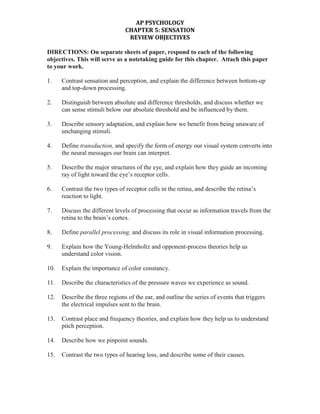
Chapter 5 review qs
- 1. DIRECTIONS: On separate sheets of paper, respond to each of the following objectives. This will serve as a notetaking guide for this chapter. Attach this paper to your work. <br />1.Contrast sensation and perception, and explain the difference between bottom-up and top-down processing.<br />2.Distinguish between absolute and difference thresholds, and discuss whether we can sense stimuli below our absolute threshold and be influenced by them.<br />3.Describe sensory adaptation, and explain how we benefit from being unaware of unchanging stimuli.<br />4.Define transduction, and specify the form of energy our visual system converts into the neural messages our brain can interpret.<br />5.Describe the major structures of the eye, and explain how they guide an incoming ray of light toward the eye’s receptor cells.<br />6.Contrast the two types of receptor cells in the retina, and describe the retina’s reaction to light. <br />7.Discuss the different levels of processing that occur as information travels from the retina to the brain’s cortex. <br />8.Define parallel processing, and discuss its role in visual information processing. <br />9.Explain how the Young-Helmholtz and opponent-process theories help us understand color vision.<br />10.Explain the importance of color constancy.<br />11.Describe the characteristics of the pressure waves we experience as sound.<br />12.Describe the three regions of the ear, and outline the series of events that triggers the electrical impulses sent to the brain.<br />13.Contrast place and frequency theories, and explain how they help us to understand pitch perception. <br />14.Describe how we pinpoint sounds. <br />15.Contrast the two types of hearing loss, and describe some of their causes. <br />16.Describe how cochlear implants function, and explain why Deaf culture advocates object to these devices. <br />17.Describe the sense of touch.<br />18.State the purpose of pain, and describe the biopsychosocial approach to pain. <br />19.Describe the sense of taste, and explain the principle of sensory interaction. <br />20.Describe the sense of smell, and explain why specific odors so easily trigger memories. <br />21.Distinguish between kinesthesis and the vestibular sense.<br />
